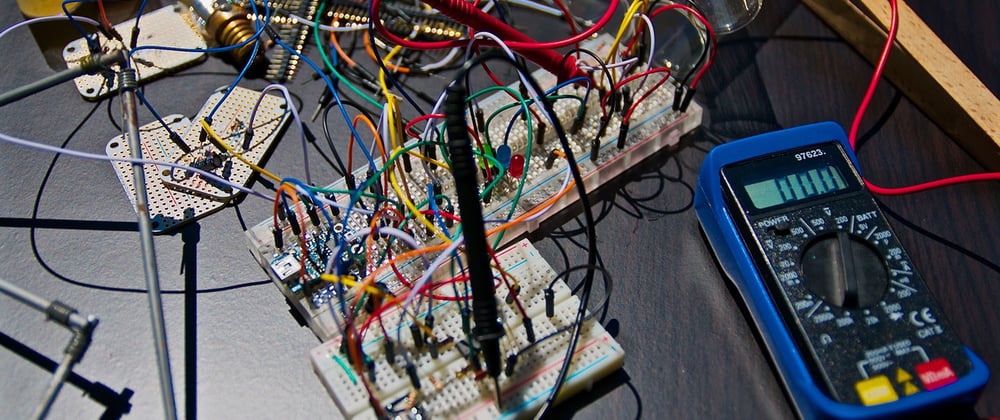I wrote this a while ago (on 15 Dec 2014, according to GitHub) but for some reason I never wrote about it or shared it really. It's a solution for using SPI with the MCP3008 ADC chip & a TMP36 analogue temperature sensor.
I wanted to find a way to use analogue readings (such as from temperature sensors, light dependent resistors etc) but digitally, from within a node application for example. Specifically, I wanted to cut out the Arduino step that most of these projects tend to take.
That's where the MCP3008 ADC chip comes in. The MCP3008 is an analogue–serial convert with an SPI or Serial Peripheral Interface. The code below shows how you'd make use of this with node.
Unfortunately, I can't locate a photo of the circuit but from what I recall, it was fairly straight forward. The code has this note:
You are required to have an SPI-able machine, such as a Raspberry Pi. For this test, I have two TMP36 chips wired up to feed data into CH0 and CH1 of a MCP3008 ADC chip.
I think programming is fun, but I find the intangibility of the things we create frustrating at times. For 20 years now, I've mostly authored digital creations, but I think the knowledge we have as software engineers can so easily be meshed with the physical world. That's why I'm sharing this.
"use strict";
var util = require('util'),
fs = require('fs'),
SPI = require('spi');
var device = '/dev/spidev0.0',
spi;
if (!fs.existsSync(device)) {
throw 'Error, SPI is not activated';
}
function read(channel, callback) {
if (spi === undefined) return;
// to select the channel, we need to compute a mode (4 bits)
// a mode consists of a single/diff bit and three selection bits (d2, d1, d0)
// if we want the input configuration to be single-ended, we use 1, for differential, use 0
// for the channel, if we add that to 8 (which is 0000 1000), we should get the right value
// ch0 = 1000, ch1 = 1001, ch2 = 1010, ch3 = 1011
// ch4 = 1100, ch5 = 1101, ch6 = 1110, ch7 = 1111
// now we need to pad this with 4 bits, to give us a byte:
// ch0 = 1000 << 4 = 1000 0000
var mode = (8 + channel) << 4;
var tx = new Buffer([1, mode, 0]);
var rx = new Buffer([0, 0, 0]);
spi.transfer(tx, rx, function(dev, buffer) {
// logic explained:
// the buffer will hold 3 8-bit bytes (24 bits) but we only want the last 10 bits
// this is the last byte and the last 2 bits from the second byte, we ignore the first byte
// | 0 | | 1 | | 2 |
// 0000 0000 0000 0000 0000 0000
// ^^^ ^^^^ ^^^^
// step 1.
// we take the second byte and bitwise AND it with 3 (0000 0011) to extract the last two bits
// 1010 0010 (162) let's say the byte has some junk data and then two at the end
// & 0000 0011 (3) we and it with three
// = 0000 0010 (2) and we get the value two
// step 2.
// we now want to shift these bits 8 to the left to make space for the third byte
// byte 1 = 0000 0010 (2) <- 8 = 10 0000 0000 (512)
// byte 2 = 0000 1111 (15) | space |
// step 3.
// we can now add them together to get two bytes equaling our value:
// 0000 0010 0000 1111 (527)
var value = ((buffer[1] & 3) << 8) + buffer[2];
callback(value);
})
}
function tmp36_temp(value) {
// approx 25 C = 750 mV (0.75 V)
// 25 / 0.75 = 33.33 C/V
// I think? http://www.analog.com/static/imported-files/data_sheets/TMP35_36_37.pdf
var volts = (value * 3.3) / 1023;
var temp = volts * 33.333;
return temp.toFixed(2);
}
function get_volts(value) {
var volts = (value * 3.3) / 1023;
return volts.toFixed(2);
}
spi = new SPI.Spi(device, [], function(s) {
s.open();
});
// read from ch0
read(0, function(value) {
console.log('Sensor 1 is %s C (%s - %s v)', tmp36_temp(value), value, get_volts(value));
})
// read from ch1
read(1, function(value) {
console.log('Sensor 2 is %s C (%s - %s v)', tmp36_temp(value), value, get_volts(value));
})
spi.close();







Latest comments (0)